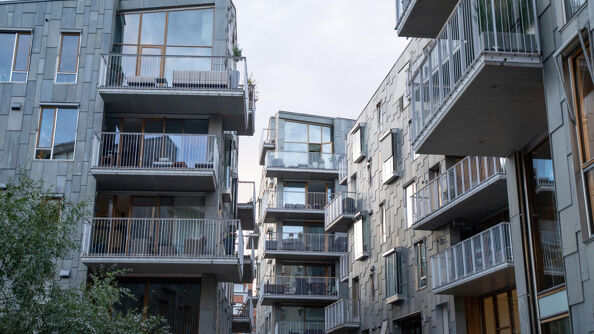Oslo's housing market
Understand price levels, neighborhoods, and where to find reliable housing statistics and support

Finding affordable housing in a suitable neighborhood is one of the most important steps in feeling at home and settled in Oslo. Whether you're planning to rent or buy, understanding the housing market can help you make informed decisions and avoid surprises.
Choosing a neighborhood that fits your lifestyle
Oslo is a compact city, and many surrounding areas offer good public transport, local shops, and easier access to nature. These neighborhoods can be more affordable and still provide a high quality of life.
Here are a few popular neighborhoods that are close to the city centre to consider:
- Grünerløkka: A lively and creative district known for its nightlife, cafés, and street art.
- Majorstuen and Frogner: Two upscale areas with high-end shopping and proximity to Frogner Park, offering elegant architecture, green spaces, and a quieter residential feel.
- Tøyen & Grønland: Two diverse and culturally rich neighborhoods with museums and community events.
The neighborhoods closer to the city centre primarily feature neighborhoods, with detached houses being more common in outer boroughs and suburban areas.
When choosing a neighborhood, think about your lifestyle, commute, and budget. Some areas are more family-friendly, while others appeal to students or young professionals.
- Explore Oslo's boroughs with Visit Oslo.
- Visit this map of green spaces around Oslo.
- Learn more about public transportation and getting around Oslo.
- Facts and statistics about Oslo's neighborhoods (in Norwegian).
If you’re unfamiliar with Oslo’s layout, it’s worth exploring boroughs and neighborhoods online or asking locals for recommendations. Travel blogs, forums, and guides often describe the character of different areas—from family-friendly suburbs to lively urban districts.
Housing costs in Oslo
Oslo's property market stands as one of Europe's most expensive, according to Investropa.
This is often the biggest factor to consider when choosing where to live. The closer you are to the city center, the higher the average prices—this applies to both rental and purchase properties.
Central districts like Frogner and Majorstuen tend to be the most expensive. Outer areas such as Groruddalen offer more affordable options, especially for families or newcomers looking for larger spaces.
- Read Oslo kommune (Oslo Municipality)'s page on housing prices (in Norwegian).
Checking for real estate on FINN.no and filtering by neighborhood, or using the map function, is another great way to compare prices by area.
Financial support and social services
If you’re struggling to enter the housing market, there are support schemes available.
-
The Norwegian State Housing Bank (Husbanken) offers start-up loans (startlån) for eligible applicants: Go to husbanken.no
-
The City of Oslo provides housing support for low-income residents: Read about housing support in Oslo (in Norwegian)
These services can help you access temporary housing, apply for subsidies, or get advice on navigating the rental market.
How to understand Oslo's housing market
Getting to know the housing market takes time, but there are several ways to start:
- Browse housing listing sites to compare prices and locations
- Attend public viewings to get a sense of what’s available
- Research public transport, parking rules, and traffic patterns
- Use Google Street View to explore neighborhoods virtually
- Ask friends, colleagues, or social media groups for advice
- Search for “neighborhoods in Oslo” to find articles and guides
These steps can help you narrow down your options and feel more confident about where to live.
The market is influenced by supply and demand, seasonal trends, and new construction projects. Staying informed can help you spot good opportunities.
Understanding Oslo's housing trends through data
- If you are comfortable reading statistics, or you have someone to help you translate, these sources might be informative.
- See Bydelsfakta (facts and numbers about the boroughs) by Oslo kommune (in Norwegian).
- Go to ssb.no to see statistics about housing (in Norwegian).
- Find general information about housing (bolig) in the Store Norsk Leksikon, the official Norwegian encyclopedia (in Norwegian).
Statistics and numbers about the rental market
- Statistics Norway (SSB) provides national statistics about rented properties broken down by square meters, number of rooms and local area: Go to ssb.no to see the rental market survey.
- Boligbygg Oslo is responsible for all the municipal properties in Oslo:See average rental prices in Oslo by Boligbygg (in Norwegian)
- Hybel.no is a private company in the rental market. They provide statistics for the biggest cities, here filtered by Oslo: Go to hybel.no for statistics about rented properties in Oslo
Statistics about house ownership in Oslo
If you’re planning to buy property, real estate agents can provide detailed information about price levels, regulations, and the buying process in Norway. Many banks and investment advisers also publish market analyses and forecasts.
Many banks and investment advisers also regularly publish prognosis and analysis about the property market.
The Norwegian Association of Real Estate Agents (NEF) offers articles about buying and selling homes, price statistics for sold properties, historical price data for individual homes, and a Norwegian-English vocabulary list related to housing.
- Go to nef.no for price statistics and resources (in Norwegian)
- Go to nef.no for detailed information about historical prices for individual properties (in Norwegian)
- Go to nef.no for a list of Norwegian-English vocabulary regarding housing (pdf)
These sources offer both national and local perspectives on housing availability, pricing, and market development.
Finding your place in Oslo
Navigating the housing market in a new city can be challenging, but Oslo offers a range of neighborhoods and support services to help you find a place that suits your needs. By understanding local trends, exploring different areas, and using available resources, you’ll be better equipped to make informed choices and feel at home in Norway’s capital.
Read more from Welcome to Oslo: